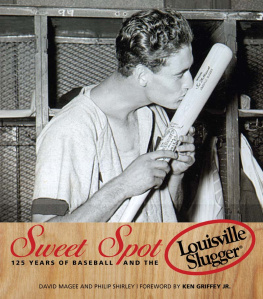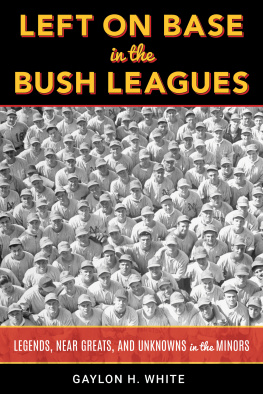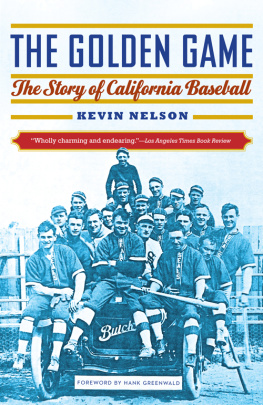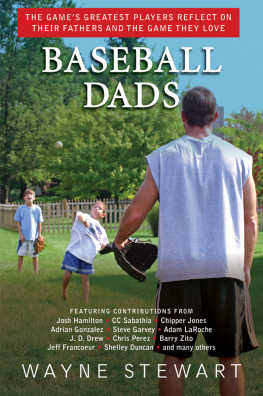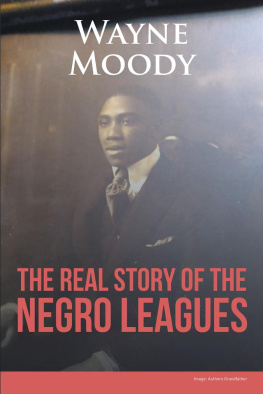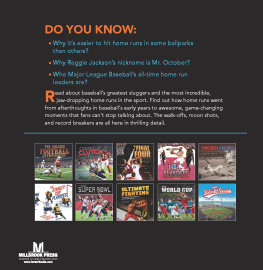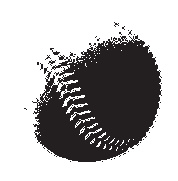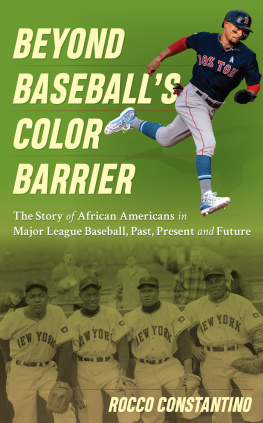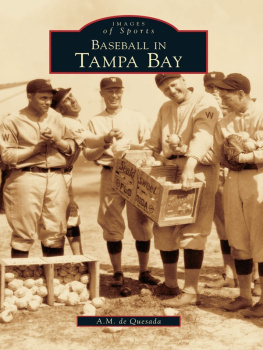Copyright 2009 by David Magee and Philip Shirley
No part of this publication may be reproduced, stored in a retrieval system, or transmitted in any form by any means, electronic, mechanical, photocopying, or otherwise, without the prior written permission of the publisher, Triumph Books, 542 South Dearborn Street, Suite 750, Chicago, Illinois 60605.
Triumph Books and colophon are registered trademarks of Random House, Inc.
Library of Congress Cataloging-in-Publication Data
Magee, David.
Sweet spot : 125 years of baseball and the Louisville slugger / David Magee and Philip Shirley.
p. cm.
ISBN 978-1-60078-176-6
1. BaseballUnited StatesEquipment and suppliesHistory. 2. Baseball bats United StatesHistory. 3. BaseballUnited StatesHistory. I. Shirley, Philip. II. Title.
GV879.7.M34 2009
688.76357dc22
2008055273
This book is available in quantity at special discounts for your group or organization. For further information, contact:
Triumph Books
542 South Dearborn Street
Suite 750
Chicago, Illinois 60605
(312) 939-3330
Fax (312) 663-3557
Printed in U.S.A.
ISBN: 978-1-60078-176-6
Design by Wagner/Donovan Design, Chicago, IL
Photos courtesy of Hillerich & Bradsby Co. unless otherwise indicated
For my mother, who signed me up for baseball each and every summer.
D.M.
To Mozelle Purvis Shirley, for passing along her love of books, education, learning, and yes, sports, too.
P.S.
Ive used the same batsame model, same sizesince day one in the minor leagues.
DEREK JETER, NEW YORK YANKEES SHORTSTOP AND NINE-TIME ALL-STAR

CONTENTS

Foreword
BY KEN GRIFFEY JR.
Sports, and the desire to be part of a winning team, have always been important in my family. My grandfather played baseball in high school, where he was a teammate of Stan Musial. My grandmother played basketball in high school, and my mother was a volleyball player. I played football at Cincinnatis Moeller High School and was fortunate to be part of an Ohio state championship team my junior year. But my senior year in high school, I stopped playing football to focus on my true love of all the sportsbaseball.
Growing up in the shadow of Major League Baseball during my fathers 19-year playing career, I had the unique opportunity to learn the game from the inside out. When my dad, Ken Griffey Sr., starred as an outfielder for Cincinnati during the Big Red Machines two World Series wins in the 1970s, I was barely in grade school, but I was getting an education whether I knew it or not.
My father brought me into the clubhouse on a regular basis, and I learned firsthand about baseballs unique competition and time-tested tradition. Looking back, some might wonder why he let me hang around the ballpark so much at such a young age. I ran around the place with Pete Rose Jr. and Tony Perezs boys, Eddie and Victor, and we played games of pickle, where we threw the ball back and forth, trying to get the runner out.
My father knew how much it meant to me, being around both him and the big-league game. I always wanted to wear his cap, even though it was too big. I would flip it around backward so I could see. Anything I could do to get closer to him and closer to baseball. It was always that way, Im told. My parents say I started carrying around an oversized plastic baseball bat about the same time I started walking. I never wanted to put it down.
By the time I was 11, I was having what should have been considered a pretty good season in the youth league. Nobody got me out until the end of the year, but when they did, I cried so hard my coach had to take me out of the game. Often when my father had a day off and came to watch me play in high school, I struggled at the plate, trying a little bit too hard. The next time at bat, though, I was confident I could hit the ball out of the park. Thats the thing about baseball. Its a game of possibilities against the most challenging odds. The possibilities keep us coming back for more.
After my junior year of football, I felt I needed to concentrate on just one sport. In football, I was a running back, and my father advised me that I could play a little longer in baseball than football. Even though I enjoyed my time as a running back in high school, I didnt care all that much for getting hit. So that was it. Baseball would be the sport I would concentrate on. The next year, 1987, I was drafted in the first round by the Seattle Mariners, and I remember thinking I wanted to get to the big leagues within about 15 minutes.
It did not happen that quickly, but when the Mariners put me in the lineup in 1989, my father was still playing as a professional. The next year, we would take the field together. As I look back over the years of my own career, the first time we played on the same field, wearing the same uniform, is a highlight.
The date was August 31, 1990. My father had just been signed by the Mariners, and we were both penciled in the lineup, batting back-to-back. My fathers first time up, he got a hit. My first time up, I got a hit, too. The very next month, we had back-to-back home runs in a game. That had never happened before in Major League Baseball, a father and son playing at the same time, and the experience is something I will never forget.
The experience was fitting since through him I observed the dedication and practice it takes to become successful. He worked with me constantly, and we always tried new things. He believed that the game was 90 percent mental and only 10 percent physical, but that didnt keep him from trying to find the perfect equipment. We tried different shoes. We tested all sorts of gloves. We even tested a few bats, but we quickly settled on the Louisville Slugger, and that became one piece of equipment we never changed again.
The link we experienced, beginning with my fathers playing days in the early 1970s and continuing four decades later, is similar to the link many players and fans alike have to baseball. The game changes over the years. Players run faster. Balls are hit harder. New ballparks are built. But the one thing that does not change is baseballs connection to the past, and for many of us that starts with Louisville Slugger, the bat that has been a part of the game for 125 years.
I was in my first year with Seattle when I signed on to put my name on a Louisville Slugger. About the only thing my father and I ever disagreed on relating to bats was which model Louisville Slugger was the best. He wanted me to use the S216 like he did, but I prefer the C271 with its smaller barrel. At 34 inches long and 31 ounces, it is one of the smallest bats used in the big leagues, but I always liked the speed I can get with it.
Over the years I have been able to get to know the people at Hillerich & Bradsby Co., makers of Louisville Slugger. Professional player representative Chuck Schupp was the first one I knew well. Hes the one who came to Seattle to visit with me and talk about what it meant to become one of a long line of guys who had autographed bat agreements. My dad and I have visited the factory a few times and met the Hillerich family. I found that these are people who genuinely love the game. They love players and want to support them. They want to know what they can do to make bats that give a player the confidence to be his or her best. They want to be a part of history, and they understand that history cant be separated from the game itself.

